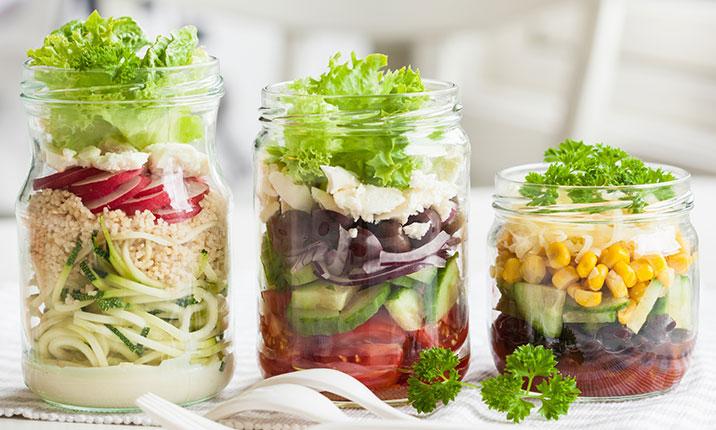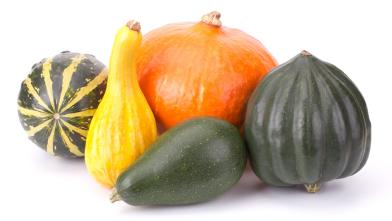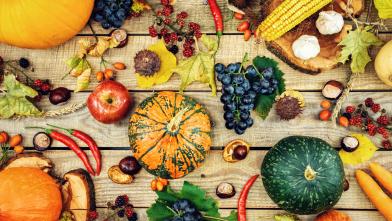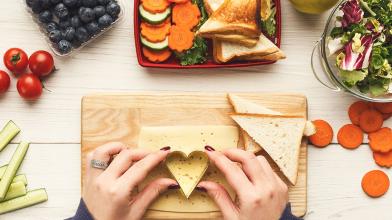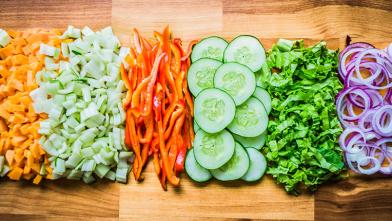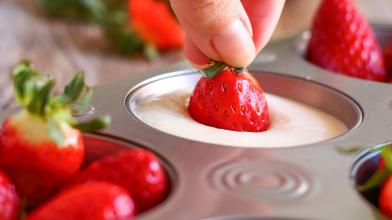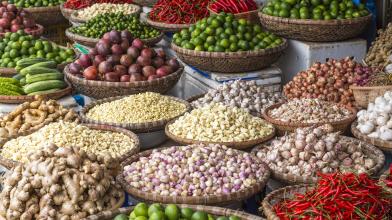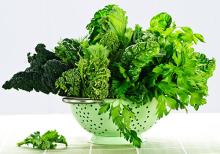
Putting together a salad is a great way to add more veggies to your meals. Salads can be a side dish or starter for a meal—or with proteins and quality carbohydrates (carbs)—they can be a diabetes-friendly meal on their own. Here’s some ideas on how to build the perfect salad to use with your eating plan!
Building Blocks of Perfect Salads

Greens: Many salads start with a base of leafy greens and there are lots of options to choose from! Light green lettuces like romaine or iceberg have a mild flavor. Darker greens like spinach and kale are more nutrient dense and have a stronger flavor.
“Spring” or “baby” greens are darker greens that are picked when the plant is young, so they also have a mild flavor. Try adding shredded cabbage or carrots to your greens for a little crunch, or arugula for a peppery taste.
Vegetables: Toss non-starchy veggies like carrots, celery, cucumber, bell pepper, broccoli, tomatoes, onion, or mushrooms into your salad. Try non-starchy veggies that you may not think about using in a salad,, like jicama, brussels sprouts, or steamed green beans.
Fruit: Fresh fruit can add sweetness to any salad. Try chopped apples or pears for something mild and crunchy. Fresh berries, orange or grapefruit slices, pineapple, peaches, or grapes are also great to add in. Fruit is a quality carb, so keep the carb content in mind for your meal plan.
Protein: Adding lean protein can turn a side salad into a meal. Cooked chicken, low-fat cheese, steamed or roasted tofu, hard boiled eggs, or fish make great choices. Adding beans or lentils can also add protein to your salad, but make sure you factor in that beans and lentils are sources of quality carbs too.
Grains: Adding whole grains along with your source of lean protein is another way to make your salad a complete meal. Whole grains are quality carbs and can offer a chewy or crunchy texture to the salad. You can try quinoa, barley, buckwheat, farro, or wheat berries.
Flavor boosters: Just a little bit of these can go a long way toward adding texture or flavor to your salad:
- Nuts and seeds like almonds, walnuts, pecans, pepitas, sunflower seeds, sesame seeds, etc. add a nice crunch.
- Dried fruit adds a chewy texture and nice burst of sweetness. NOTE: Be sure to measure out how much you add. Just two level tablespoons of dried fruit, like raisins or cranberries, will have about 15 grams of carbs.
- Something briny such as olives, pickled banana peppers, or capers can add a savory flavor. NOTE: Leave these out or use them sparingly if you are watching your sodium! Briny foods like this are made with a lot of salt.
- Cheese can add a variety of textures and flavors, depending on the type. Try lower fat cheeses like low-fat varieties of crumbled feta, goat cheese, shredded cheddar, or mozzarella.
You can prep all of these ingredients ahead of time and build a DIY Salad Bar in your own fridge! This is perfect for meal prep and makes it quick and easy to add more veggies to your eating plan.
Dress it up!
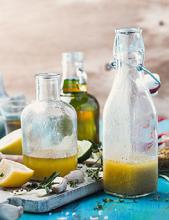
Most people use dressing they buy for their salad, but salad dressing is easy to make at home.
Store bought dressings can be high in carbohydrates and sodium. When you make your own, you can control what goes in (and what stays out!).
A basic vinaigrette consists of three parts oil, one part vinegar, and a pinch of salt and pepper. If you like tangier dressing, or want to cut down on the fat, try two parts oil to one part vinegar.
Blend your salad dressing by whisking the ingredients together in a bowl, shaking in a jar with a tight-fitting lid, or blending in a blender or food processor.
You can also switch up the flavor by trying different amounts of oil and vinegar to make a dressing that fits your own tastes.
Oil: Olive oil is the gold standard, but other oils like canola, sunflower, or corn oil work just as well with a milder flavor. Try nut oils like almond, pecan, or walnut oil for a nice nutty flavor.
Vinegar: Any vinegar can work—balsamic, red wine, apple cider, or rice—or you could try another acid such as lemon or another citrus juice.
Other salad dressing add-ins
- Fresh or dried herbs like oregano, basil, thyme, or rosemary
- Minced onion or garlic/onion or garlic powder
- Mustard or mustard powder
- Grated parmesan cheese
